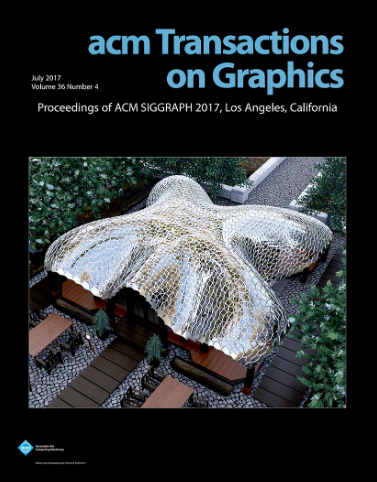Optimal r-Adaptive In-Timestep Remeshing for Elastodynamics
IF 9.5
1区 计算机科学
Q1 COMPUTER SCIENCE, SOFTWARE ENGINEERING
引用次数: 0
Abstract
We propose a coupled mesh-adaptation model and physical simulation algorithm to jointly generate, per timestep, optimal adaptive remeshings and implicit solutions for the simulation of frictionally contacting elastodynamics. To do so, we begin with Ferguson et al.'s [2023] recently developed in-timestep remeshing (ITR) framework, which proposes an Incremental Potential based objective for mesh refinement, and a corresponding, locally greedy remeshing algorithm to minimize it. While this initial ITR framework demonstrates significant improvements, its greedy remeshing does not generate optimal meshes, and so does not converge to improving physical solutions with increasing mesh resolution. In practice, due to lack of optimality, the original ITR framework can and will find mesh and state solutions with unnecessarily low-quality geometries and corresponding physical solution artifacts. At the same time, we also identify additional fundamental challenges to adaptive simulation in terms of both ITR's original remeshing objective and its corresponding optimization problem formulation. In this work, in order to extend the ITR framework to high-quality, optimal in-timestep remeshing, we first construct a new remeshing objective function built from simple, yet critical, updates to the Incremental Potential energy, and a corresponding弹性动力学最优r-自适应时间步重网格
我们提出了一种耦合的网格自适应模型和物理仿真算法,以共同生成每个时间步长的最优自适应网格和隐式解,用于模拟摩擦接触弹性动力学。为此,我们从Ferguson等人[2023]最近开发的时间步重网格(ITR)框架开始,该框架提出了一个基于增量潜力的网格细化目标,以及一个相应的局部贪婪重网格算法来最小化它。虽然这个初始的ITR框架显示出显著的改进,但它的贪婪重划分并不能生成最优的网格,因此不能随着网格分辨率的增加而收敛到改进物理解决方案。在实践中,由于缺乏最优性,原始的ITR框架可以并且将会用不必要的低质量几何图形和相应的物理解决方案工件找到网格和状态解决方案。与此同时,我们还从ITR的原始重网格目标和相应的优化问题表述方面确定了自适应仿真的其他基本挑战。在这项工作中,为了将ITR框架扩展到高质量、最优的时间步重网格,我们首先构建了一个新的重网格目标函数,该函数由简单但关键的增量势能更新构建而成,以及相应的约束模型问题,其最小化值为物理问题提供局部最优重网格。然后,我们提出了一个新的时间步内重网格优化,每个时间步,共同解决一个新的局部最优重网格和在其上定义的下一个物理状态。为了评估和证明我们对ITR框架的扩展,我们将其应用于摩擦接触弹性动力学和静力学的最佳r-自适应ITR仿真。为了实现r-自适应,我们还提出了一种新的数值方法来鲁棒计算解内最优网格到网格状态映射所需的l2投影算子的导数,一种约束模型来实现边界节点自适应,以及一种有效的牛顿型优化方法来实际求解每个时间步r-自适应ITR解。我们广泛评估了我们的方法在挑战大变形和摩擦接触场景。在这里,我们观察到最优的r- adaptive捕获的精度比未适应的网格大几个数量级,在计算加速和减少内存使用方面具有相应的显着优势。
本文章由计算机程序翻译,如有差异,请以英文原文为准。
求助全文
约1分钟内获得全文
求助全文
来源期刊

ACM Transactions on Graphics
工程技术-计算机:软件工程
CiteScore
14.30
自引率
25.80%
发文量
193
审稿时长
12 months
期刊介绍:
ACM Transactions on Graphics (TOG) is a peer-reviewed scientific journal that aims to disseminate the latest findings of note in the field of computer graphics. It has been published since 1982 by the Association for Computing Machinery. Starting in 2003, all papers accepted for presentation at the annual SIGGRAPH conference are printed in a special summer issue of the journal.
 求助内容:
求助内容: 应助结果提醒方式:
应助结果提醒方式:


